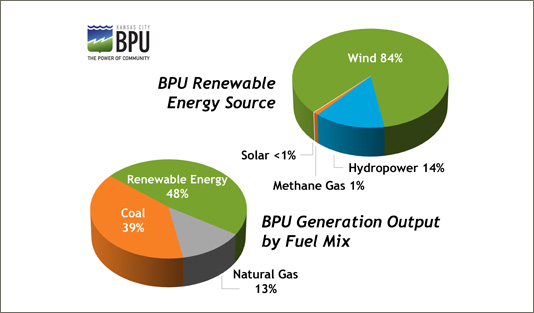(KANSAS CITY, Kan.) — The Kansas City Board of Public Utilities (BPU) has worked aggressively to diversify its energy generation capabilities over the last decade, shifting more and more toward renewable energy sources like wind, hydropower, landfill gas, and solar. While good for the environment and community health, this has also reduced BPU’s reliance on volatile gas markets and accompanying price fluctuations, which have been exacerbated by record-breaking heat waves, arctic blasts, and world events over the last several years.
Today, 48% of BPU’s energy comes from carbon-free renewable energy, exceeding the Kansas Renewable Energy Standard Goal of 20%, and helping make BPU one of the “greenest” public utilities in the nation. As a municipal utility, BPU has embraced an aggressive clean power approach – utilizing more sustainable and environmentally friendly energy alternatives.
Renewable energy sources now exceed BPU’s coal generation output for the first time in history, with coal consumption reduced 62% from 2007-2020. To achieve this, the utility relies on energy from three separate wind farms (Cimarron Bend, Smoky Hill, and Alexander) with more than 110 combined wind turbines, the Bowersock hydro-dam on the Kansas River, methane gas from the Oak Grove Landfill, and the BPU Community Solar Farm. In addition, BPU ceased all coal generation operations at its 50-year old Quindaro Power Station in 2020, determining these older units were no longer viable, efficient, or necessary in today’s marketplace.
Built in 2017, BPU’s Community Solar Farm was the first municipal solar farm in the state of Kansas. Located in Wyandotte County, it allows residential and commercial customers that want to use solar energy access to this sustainable resource from one central location, making it affordable and accessible for homeowners, renters, and even businesses that prefer to use “green” energy. Each of the solar farm’s 3,700 PV panels can eliminate 12 tons of carbon dioxide (CO2), the equivalent of planting 278 trees, or reducing single auto emissions of 23,500 miles.
In total, BPU has the capacity to power approximately 135,000 local homes from its carbon-free green renewable energy portfolio. When combining its use of renewables and changes to its existing generating units, BPU has reduced its CO2 rate by more than 51 percent over the last decade, a significant achievement.
Maintaining a broad mix of generation capabilities allows BPU to provide affordable, reliable, and environmental-friendly energy to this historic, diverse, and growing community. It also reduces the utility’s overall carbon footprint, can help improve overall health outcomes in the community, and diminishes the utility’s reliance on only a few sources of energy which can experience market/pricing volatility, or require significant environmental regulation.
In the end, renewable energy is a win-win scenario for BPU, its customers, the environment, and the entire community. Click here for more information about the utility’s environmental and clean energy efforts.
